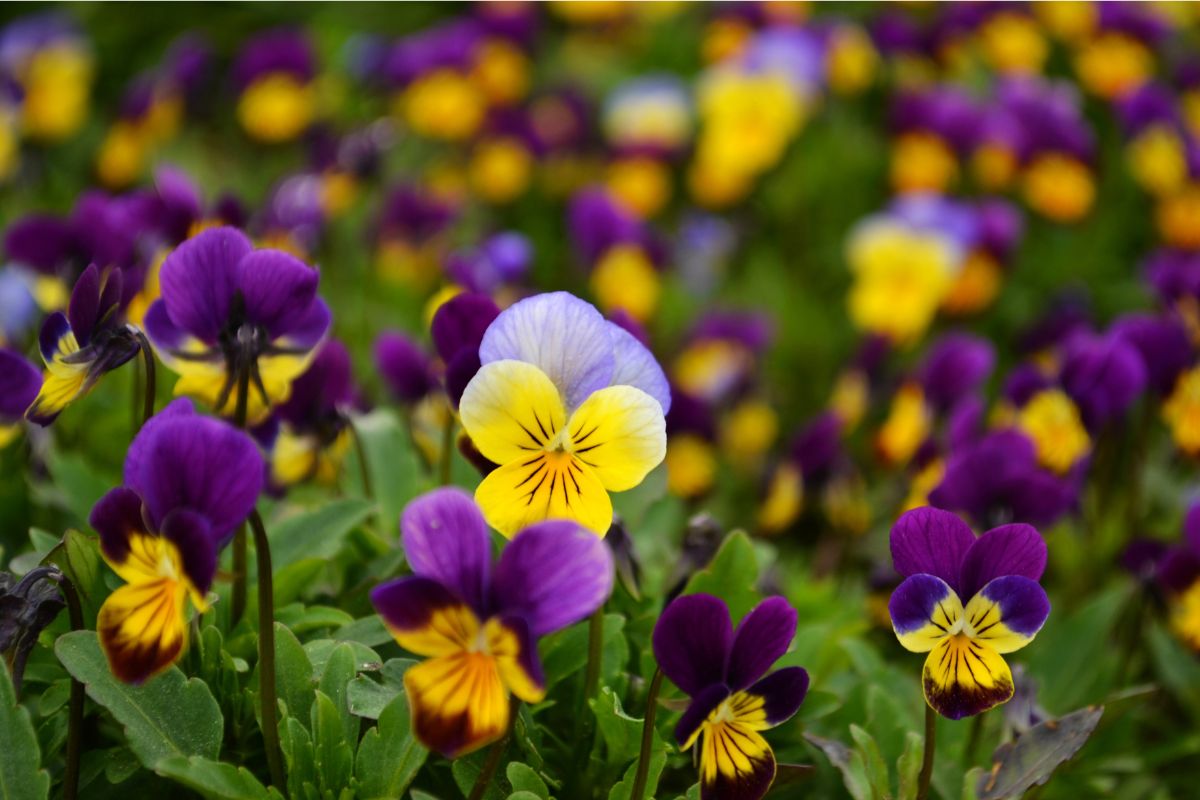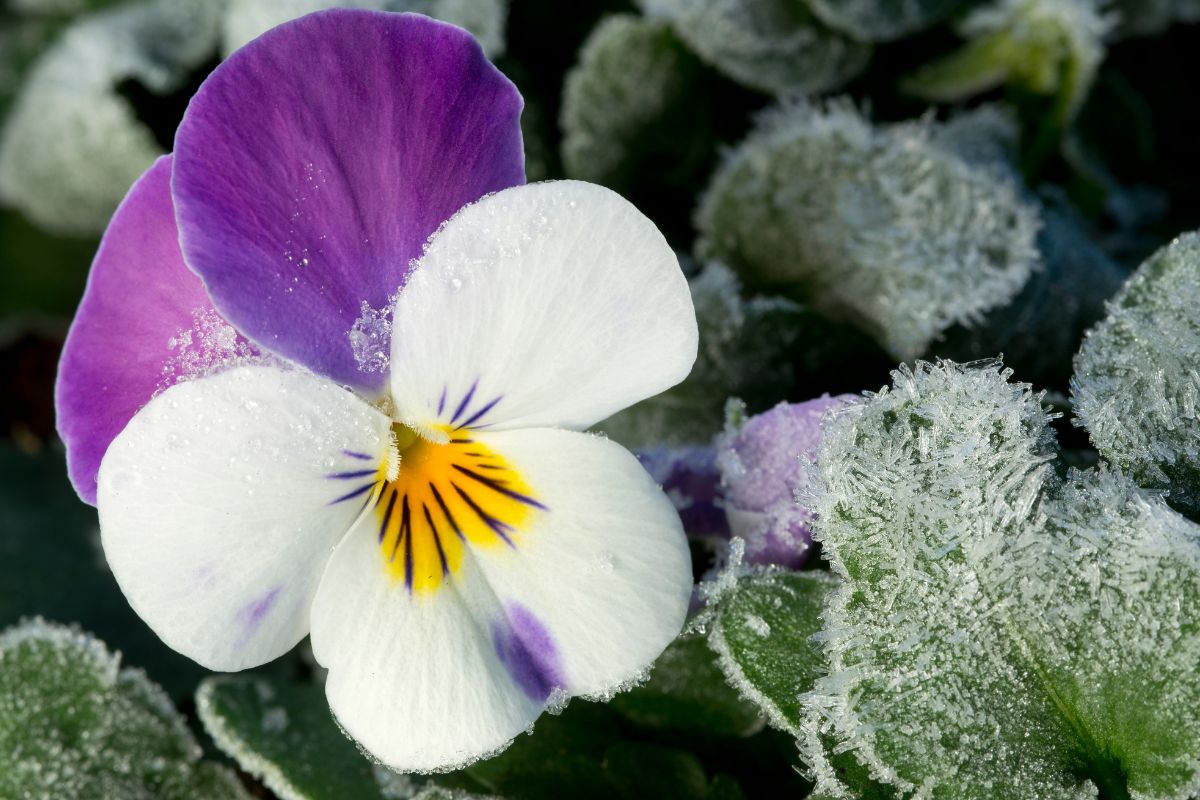The Pansy
Pansies are vibrant flowers with faces. The final say about Pansies is that they are a favorite in the cooler months and are wonderful in spring and fall gardens. But can pansies survive frost?
Nevertheless, they are a go-to flower for dependable color virtually all year round in some regions and are great for containers, borders, and ground cover. Pansies look lovely planted alongside other cool-season flowers like violas, primroses, trailing lobelia, and sweet alyssum.

Are Pansies Perennials?
You can think of the pansy as either an annual or a perennial, depending on your climate. Most gardeners classify this plant as an annual since it prefers mild temperatures and shrinks disproportionately in the summer heat. It has been difficult to create heat-tolerant pansies that can endure extreme heat.
But in colder climates, pansies are remarkably hardy. They can survive a frost and bounce back from even ten-degree temperatures. Since the plants typically live to bloom again, they make excellent blooming plants for fall and early winter colors if the blossoms fade in the cold.
Can Pansies Survive Frost?
Pansies can withstand cold weather and flourish in it, between 40 and 60 degrees Fahrenheit (4.44 and 15.55 degrees Celsius).
Although they can withstand temperatures as low as one degree Fahrenheit (17.22 degrees Celsius), pansy leaves will begin to wilt and acquire a gray-green color when the air temperature falls below 25 degrees Fahrenheit (3.88 degrees Celsius).
This is a typical defensive reaction to cold weather; when warm weather arrives, they recover quickly. Read our article and find out What Temperature Is Too Cold For Plants?
Guard Against Frost
Healthy plants can typically withstand brief temperatures as low as 0 degrees Fahrenheit (-17.78 degrees Celsius) without protection, but if you are in a frosty area, mulching your Pansies with pine straw is the best approach to prevent freezing damage.
During extremely cold weather, spread straw 2 to 4 inches (5.08 to 10.16 centimeters) thick over the top of the entire bed (plants and all). The soil won’t freeze thanks to the pine straw’s ability to retain heat, and its exposure to wind will significantly reduce. Rake the pine straw from the bed gently once the cold weather passes.

When to Plant Pansies Outside
Planting Pansies in late summer or early fall is ideal because they can bloom through the winter and the following spring. You can also grow in the spring or early summer to ensure blooming throughout the growing season. It is ideal for planting pansies in the late summer or early fall to have time to establish them before winter.
Although you can sow pansies directly since they are hardy perennials that can resist the cold, you will receive more reliable results if you spread them covertly.
Spread the seeds thinly over trays or pots of damp seed compost and cover them with some compost. Place the seeds on a warm, well-lit windowsill, cover the tray with a lid, or place it in a clear plastic bag.
Remove the lid/bag once the seedlings are visible and continue to grow them until they are big enough to go into individual pots. Start them off in your borders if you prefer sowing in soil that you rake to a fine tilth and is free of weeds, roots, and stones.
Avoid planting your undercover pansies in areas where they have previously grown because the soil can contain leaf-spot fungus spores in the fall. Instead, harden off and plant your undercover pansies outside.
It’s simple to add color to a garden at this time instantly. One container display alone can create a striking center of attention. A single huge pot can have a greater influence than numerous little pots dispersed over the area. Garden centers and nurseries will offer a decent selection of colorful, affordable pansy plants between March and May.
To prevent having to switch out the display every few weeks, look for plants that bloom for several months. Pansies are a low-cost method to add color to pots and produce many flowers throughout the summer. Even though the care of pansies in pots may be slightly more expensive, you can place them in the garden once they outgrow their containers.
They thrive in either full sun or little shade. Pansies may create a display on their own or in combination with other flower bed ideas in garden borders and edges. They’re a colorful alternative for sprucing up bare or neglected backyard sections.
As the spring bulbs like tulips and dahlias climb up through and between the flowering pansies, they create the ideal companions.
How Cold Can Pansies Tolerate?
Winter Pansies can not only withstand freezing weather but also bloom all winter long and continue the beautiful display the next spring. Even while pansies can withstand temperatures below 26 degrees Fahrenheit (3.33 degrees Celsius), there are additional elements that you must consider before determining if they will live.
Air and soil temperatures influence the survival of pansies over the winter. Even the timing of fertilizer application can weaken a pansy plant that is otherwise healthy and make it more vulnerable to winter damage.
The Effect of Cold Temperatures
Can pansies survive frost? Pansies switch to defense mode when the air temperature drops below 25 degrees Fahrenheit (3.88 degrees Celsius). Their usually green foliage could wilt and turn brownish. However, this does not indicate that they are dying; instead, it is their typical reaction to below-freezing conditions.
However, there are situations when soil temperature has a bigger impact on pansy demise than air temperature. There’s an inability of the plant roots to absorb water and nutrients when the earth freezes solid. And they will become dehydrated if this occurs. The University of Georgia Extension provides a noteworthy case study that exemplifies this idea.
Some people arranged Pansies in a flower bed, with one side facing north and the other facing south. The soil was 45 degrees Fahrenheit (7.22 degrees Celsius) on the south-facing side, but it froze over around the root balls of the pansies on the north-facing side.
The north-facing pansies became dehydrated and eventually died because they could not absorb water through the frozen soil. The same logic holds when growing pansies in containers, which raise the plants’ root balls above the soil’s protective insulation.
Our Pansy Survival Tips
How long do pansies last? Pansies can last one season with correct planting and routine garden maintenance for a single spring or fall color show. However, give pansy plantings some additional care if your environment permits winter displays or you’re counting on a repeat spring performance:
- Feeding: Prolific pansy blooms survive by regular feedings throughout active growth. The full, balanced nourishment includes the additional iron that pansies require. Fertilize in the fall and once more when the ground thaws and spring growth starts in areas where fall-planted pansies take a winter rest.
- Watering: While roots won’t tolerate damp soil, consistent watering keeps pansy blooms smooth and pliable. During the growing season, water pansies often, but the soil gets a little dry in between applications. Additionally, pansies become more resistant to cold and may withstand dry soil conditions.
- Protecting: Organic mulch keeps soil moisture safe during the flowering season and deters weed growth. A protective layer of straw shields roots from sudden temperature changes and heaving throughout the cold winter months. Once the ground freezes, spread straw over it; once the snow and ice melt in the spring, remove it. Don’t worry if you discover pansy buds that are eager to bloom.
- Aphids and spider mites are two insects that pansies are vulnerable to. Tiny holes and brown patches on leaves are two examples of visible damage. Spray an insect killer evenly while keeping the sprayer about a foot (0.305 meters) away from the target region.
- You can bet on the cool-weather color that prolongs the season and your delight when you include pansies in your garden planning.

The Bottom Line
Pansies, typically fall annuals, come in various hues and patterns and add cheery blossoms to a bleak landscape. But how long do Pansies last? In warmer climates, pansies are great annuals that survive the winter and spring (zones four and up).
When most other flowers finish blooming for the season, they offer gorgeous color. Winter is a time of abundant green, so adding a splash of color is a terrific idea.
Pansies are normally cultivated annually, but they can also be hardy biennials with a short lifespan in the right conditions. They are trendy throughout the United States, but they live longer in regions with frequent extended periods without frost. When extremely hot weather strikes and summer flowers take over, they deteriorate and die.
Your lowest and warmest temperatures will determine how long pansies last for you. Too cold or too hot temperatures might cause pansies to wither.
